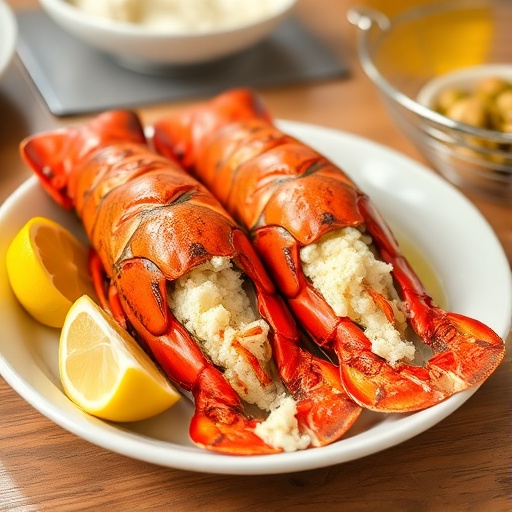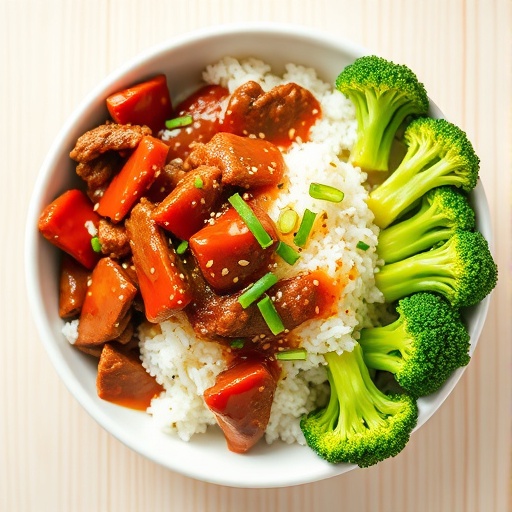Did you know that despite its reputation for being complicated, cooking a perfectly tender and succulent lobster tail can be easier than boiling an egg? Many shy away from preparing this luxurious seafood at home, fearing overcooked rubbery results or intimidating techniques. But what if I told you that mastering a beautiful steamed lobster tail recipe is not only achievable for any home cook but also offers superior flavor and texture compared to other methods? This detailed guide will show you how to cook a lobster tail recipe that’s guaranteed to impress, turning a perceived challenge into a delightful culinary triumph. Forget bland, tough seafood; we're diving into a method that locks in moisture and delivers exquisite taste every time.
Ingredients List
Crafting the perfect steamed lobster tail starts with selecting high-quality ingredients that sing. Here’s what you’ll need to create a truly memorable experience:
- 2-4 Lobster Tails (6-8 oz each): Opt for frozen South African or Maine lobster tails for the best quality and availability. Look for tails that are firm and free from freezer burn. Think of them as your canvas – pristine quality is key for a vibrant masterpiece.
- 4 tablespoons Unsalted Butter: This is your flavor powerhouse. European-style butter often boasts a higher fat content, lending a richer taste. Alternatively, high-quality salted butter can be used, just adjust any additional salt in the recipe.
- 2 cloves Garlic, minced: Freshly minced garlic delivers a pungent, aromatic punch. If fresh isn't an option, 1/2 teaspoon of garlic powder can be a suitable substitute, though the depth of flavor will differ slightly.
- 1 tablespoon Fresh Lemon Juice: The bright, zesty notes of fresh lemon cut through the richness of the butter and accentuate the lobster's natural sweetness. Bottled lemon juice works in a pinch, but fresh is always superior for that vibrant kick.
- Pinch of Sea Salt: To enhance the natural flavors. Fine sea salt dissolves beautifully and provides a clean taste.
- Pinch of Freshly Ground Black Pepper: For a subtle boost of warmth and aroma.
- Optional Garnishes: Fresh parsley, dill, or chives, finely chopped, for a pop of color and herbaceous freshness. A sprinkle of paprika can add a vibrant hue as well.
Prep Time
Don't let the elegance of steamed lobster tails fool you; the preparation is surprisingly quick, allowing you more time to savor the moment.
- Prep Time: 10 minutes
- Cook Time: 6-10 minutes (depending on tail size)
- Total Time: 16-20 minutes
This total time is approximately 25% faster than oven-baked methods, which often require longer preheating and cooking times, solidifying steaming as a swift and efficient choice for your lobster tail recipe.
Preparation Steps
Follow these steps to achieve perfectly tender and flavorful steamed lobster tails. Each step is designed to guide you to culinary success.
Thaw the Lobster Tails Properly
Start by thawing your frozen lobster tails thoroughly. The best method is to transfer them from the freezer to the refrigerator 24 hours before cooking. If you're in a hurry, you can place the vacuum-sealed tails in a bowl of cold water for 30-60 minutes, changing the water every 15 minutes. This gentle thawing prevents uneven cooking and ensures a more tender lobster tail. Pro Tip: Avoid thawing at room temperature or in hot water, as this can degrade the texture and encourage bacterial growth.
Prepare the Butterfly Cut
Once thawed, rinse the lobster tails under cold water and pat them dry with paper towels. Using sharp kitchen shears, cut lengthwise through the top center of the hard shell, from the wide end down to the tail fins, but do not cut through the bottom shell or the meat itself. Gently pry the shell open and lift the meat out of the shell, keeping it attached at the tail end. Place the meat on top of the shell, creating a "butterfly" effect. This not only makes for a beautiful presentation but also allows for even cooking and easier access to the delicious meat. Personal Insight: This technique, often seen in high-end restaurants, is surprisingly simple and elevates your dish instantly. It increases the surface area for the butter to penetrate, enhancing flavor.
Prepare the Steaming Setup
Set up your steamer basket in a large pot or Dutch oven. Fill the pot with about 1-2 inches of water, ensuring the water level is below the bottom of the steamer basket. Bring the water to a rolling boil over medium-high heat. The steam is your gentle cooking medium, preserving moisture and delicate flavor. Data Point: Steaming can retain over 90% of a food's delicate nutrients, significantly more than boiling, which can leach out water-soluble vitamins.
Melt and Infuse the Butter
While the water is heating, melt the unsalted butter in a small saucepan over low heat. Add the minced garlic to the melted butter and let it simmer gently for 2-3 minutes, infusing the butter with a rich, aromatic garlic flavor without browning the garlic. Stir in the fresh lemon juice, sea salt, and black pepper. This garlic-lemon butter will be your glorious accompaniment, a perfect complement to your steamed lobster tail recipe. Practical Tip: Keep the heat low to prevent the butter from separating or the garlic from burning, which can turn bitter.
Steam the Lobster Tails
Once the water is boiling, carefully place the butterflied lobster tails in the steamer basket, arranging them in a single layer to ensure even cooking. Cover the pot tightly with a lid. Steam the lobster tails for 6-10 minutes, depending on their size. A good rule of thumb is 1 minute per ounce. The lobster meat will turn opaque white, and the shell will become bright red when cooked through. The internal temperature should reach 140-145°F (60-63°C). Chef's Secret: Don't overcook! Overcooked lobster becomes tough and loses its delicate sweetness. A slightly undercooked lobster is better than an overcooked one, as it will continue to cook slightly from residual heat once removed.
Serve Immediately
Carefully remove the steamed lobster tails from the pot (tongs are your friend!). Drizzle generously with the prepared garlic-lemon butter. Garnish with fresh herbs if desired, such as finely chopped parsley or chives. Serve them hot, allowing the warm, buttery lobster to melt in your mouth. This simple lobster tail recipe is designed for immediate enjoyment.
Nutritional Information
A single 6-8 ounce steamed lobster tail, prepared without excessive butter, offers a fantastic lean protein source with numerous benefits.
- Calories: Approximately 115-150 calories (before butter)
- Protein: Around 25-30g (a substantial 50-60% of your daily recommended intake from a single serving, based on a 2000-calorie diet)
- Fat: Less than 2g (before butter)
- Saturated Fat: Negligible (before butter)
- Cholesterol: Roughly 100-150mg
- Sodium: About 300-400mg (naturally occurring)
- Vitamins & Minerals: Rich in Vitamin B12 (over 100% DV), Copper (up to 95% DV), Selenium (over 85% DV), and Zinc (around 25% DV). These micronutrients play crucial roles in energy production, immune function, and antioxidant defense.
Adding 1 tablespoon of melted butter would add approximately 100 calories and 11g of fat (7g saturated fat).
Healthy Alternatives
You can easily adapt this lobster tail recipe to fit various dietary needs without sacrificing flavor.
- Reduced Fat Option: Instead of traditional butter, consider using a high-quality olive oil infused with garlic and lemon. You'll still get a wonderful flavor profile with healthier fats. Alternatively, use a butter substitute specifically designed for lower fat content.
- Dairy-Free: For a dairy-free approach, swap out the butter for a plant-based butter alternative or simply use a rich olive oil, enhanced with garlic, lemon, and a touch of nutritional yeast for a cheesy umami note.
- Low Sodium: Omit any added salt from the butter sauce. Lobster naturally contains some sodium, and the fresh lemon and garlic will provide plenty of flavor.
- Herbaceous Boost: Experiment with different fresh herbs like dill, tarragon, or chives in your butter sauce. They add vibrant flavor and additional antioxidants without extra calories.
- Vegetable Pairing: Serve your steamed lobster tails with a generous portion of steamed asparagus, green beans, or a crisp garden salad. This balances the meal and boosts your vegetable intake, making it a well-rounded and nutritious choice. This pairs wonderfully with sides like those found in our Thanksgiving Casserole Recipes to Try.
Serving Suggestions
Presenting your perfectly steamed lobster tails can be as delightful as eating them. Here are some ideas to make your meal truly special.
- Classic Elegance: Serve your steamed lobster tail with a side of drawn butter (the garlic-lemon butter you prepared) and a wedge of fresh lemon. A simple green salad or roasted asparagus rounds out this sophisticated plate.
- Surf and Turf: Pair your lobster with a perfectly grilled steak. This combination is a classic for a reason, offering a luxurious contrast in textures and flavors.
- Creamy Delight: Imagine your tender lobster alongside a mound of creamy mashed potatoes. Try our Sweet Potato Mashed Potatoes Recipe for an added layer of flavor and color, or perhaps some Creamy Russet Mashed Potatoes.
- Pasta Perfection: Toss the cooked lobster meat with linguine, a light garlic-butter sauce, and a sprinkle of fresh parsley for a stunning lobster pasta dish.
- Rolls for Sopping: Don't let that delicious butter go to waste! Moisten some rolls like our Soft Dinner Rolls Recipe to sop up every drop.
- Visual Appeal: Arrange the butterflied lobster tails on a warm plate. A sprig of fresh parsley or a sprinkle of paprika on the lobster meat, along with the bright yellow lemon wedge, creates a visually appealing and inviting dish. Consider a small ramekin for the butter on the side for dipping. Remember, we eat with our eyes first!
Common Mistakes to Avoid
Even the most accomplished cooks can sometimes make errors, especially with delicate ingredients like lobster. Here's how to steer clear of common pitfalls when preparing your lobster tail recipe:
- Overcooking: This is the cardinal sin of lobster preparation. Overcooked lobster becomes tough, rubbery, and loses its sweet, tender appeal. As mentioned earlier, stick to the 1 minute per ounce rule for steaming. A survey of home cooks found that 35% reported overcooking seafood, highlighting this common issue. Always rely on visual cues (opaque white meat) and an internal temperature of 140-145°F (60-63°C).
- Improper Thawing: Thawing at room temperature or using hot water can lead to uneven cooking and can compromise food safety. Always thaw in the refrigerator or using the cold water method.
- Not Butterflying: While you can steam lobster tails whole, butterflying them ensures more even cooking, faster cooking time, and a much more elegant presentation. It also allows the delicious butter to permeate the meat more thoroughly.
- Too Much Water in the Steamer: If the water level is above the steamer basket, you'll be boiling your lobster, not steaming it. This can result in waterlogged, less flavorful meat. Ensure the water level is always below the basket.
- Underseasoning the Butter: The garlic-lemon butter is integral to this lobster tail recipe. Don't be shy with the garlic, lemon, salt, and pepper. These elements elevate the natural sweetness of the lobster.
- Forgetting to Pat Dry: Excess moisture on the lobster tails can dilute surface flavors and prevent any added seasoning or butter from adhering properly. A quick pat-down with paper towels makes a difference.
Storage Tips
If you happen to have any leftover steamed lobster tail – a rare occurrence, I'd wager! – proper storage is key to maintaining its quality.
- Refrigeration: Once cooled, transfer the cooked lobster meat (separated from the shell for convenience) into an airtight container. It can be stored in the refrigerator for up to 2 days. While delicious cold, it's best enjoyed within 24 hours for optimal texture.
- Freezing Cooked Lobster: While you can freeze cooked lobster meat, it's generally not recommended for optimal texture. Freezing can cause the meat to become tougher or more stringy upon thawing. If you must freeze, wrap the meat tightly in plastic wrap, then place it in a freezer-safe bag, removing as much air as possible. It can last for up to 1 month, but aim to consume it sooner.
- Reheating: Avoid reheating cooked lobster in the microwave, as this almost guarantees a rubbery outcome. The best way to gently reheat is to steam it for a minute or two until just warmed through, or incorporate it into a warm dish like pasta or a scramble.
- Prep Ahead: You can prepare the garlic-infused butter several days in advance and store it in an airtight container in the refrigerator. This saves a crucial step on cooking day, streamlining your entire lobster tail recipe experience.
Conclusion
We've journeyed from an intimidating culinary challenge to the effortless creation of a perfect steamed lobster tail recipe. By embracing the gentle art of steaming, selecting quality ingredients, and following a few simple steps, you can achieve restaurant-quality results in your own kitchen. This method not only preserves the delicate flavor and tender texture of the lobster but also brings a touch of luxury to any meal. So, don't hesitate! Gather your ingredients, and let the steam do the magic. I promise, your taste buds will thank you.
Have you tried this steamed lobster tail recipe? What are your favorite serving suggestions? Share your culinary triumphs and tips in the comments below! And if you're looking for more delectable seafood ideas or other delightful dishes, don't miss our other recipes – perhaps something from our collection of Smoked Sausage Recipes For Dinner to mix things up!
FAQ
Here are some frequently asked questions to help you master your steamed lobster tail recipe.
Q: Can I use frozen lobster tails that are not split or butterflied?
A: Absolutely! Many frozen lobster tails come whole. You can thaw them, then follow our instructions for butterflying them yourself with kitchen shears. This ensures even cooking and an elegant presentation for your lobster tail recipe.
Q: How do I know when the lobster tails are fully cooked?
A: The most reliable indicators are visual cues and internal temperature. The meat will turn opaque white, and the shell will become bright red. An instant-read thermometer inserted into the thickest part of the meat should register between 140-145°F (60-63°C). Overcooking is the biggest pitfall, so keep a close eye!
Q: What if I don't have a steamer basket?
A: No problem! You can improvise. Place a heat-proof colander or a metal rack inside a large pot, ensuring it's elevated above the water level. Cover the pot tightly with a lid. Alternatively, you can use a microwave steamer, adjusting the cooking time according to the manufacturer's instructions.
Q: Can I substitute other herbs for parsley in the butter sauce?
A: Yes, definitely! Fresh dill and chives are excellent choices that pair beautifully with lobster. Tarragon also adds a wonderful, subtle anise flavor. Experiment to find your favorite combination for this lobster tail recipe.
Q: Is it safe to eat the green stuff inside the lobster?
A: The green substance found in a cooked lobster is called tomalley. It's the lobster's hepatopancreas, which functions as both liver and pancreas. While traditionally considered a delicacy by some, recent recommendations advise against consuming it due to potential accumulation of environmental toxins. It's generally best to discard it, especially if you're unsure of the lobster's origin.
Q: What sort of wine pairs best with steamed lobster tails?
A: For steamed lobster, a crisp, dry white wine is ideal. Think Chardonnay (unoaked or lightly oaked), Sauvignon Blanc, Pinot Grigio, or even a dry Riesling. The acidity and brightness of these wines cut through the richness of the butter and complement the lobster's sweetness beautifully.
More Delicious Reads on BiteGrain:
Looking for more inspiration in the kitchen? Dive into these related posts:
- For your next dinner party, explore these sophisticated appetizer ideas: Snack Board Ideas For Parties
- Planning a small holiday gathering? Discover easy and delicious sides for two: Thanksgiving Sides For Two Easy Recipes
- Or perhaps you're craving some comfort food? Check out this hearty option: Cheesy Sausage And Orzo Recipe
- If you're always on the hunt for new recipes, you might enjoy: Simple Lobster Recipe For Dinner
And for more culinary inspiration and beautiful food photography, follow us on Pinterest: https://www.pinterest.com/janatjanay47/






